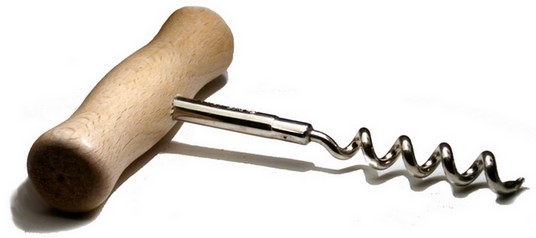According to a story in The New York Times, the Rev. Samuel Henshall was not a lucky man. His hopes of academic glory in late 18th century Oxford were scuppered when his scholarly essays flopped, and he failed to get a professorship. Once he was taken to court by a brewery to which he owed £420 – a hefty beer bill for the time.
But his boozing wasn’t entirely wasteful, because it inspired Henshall’s sole success. He invented a contraption to extract corks from wine bottles, the corkscrew, which was patented by the industrialist Matthew Boulton in 1795. Despite his failure to pay his share of the patenting expenses and a flood of complaints from rival inventors Henshall is still credited as the corkscrew’s designer. Several of his early models were buried with him.
A modern version of his invention is displayed together with a paper clip, clothespin, rubber band, egg carton, shipping container and 30 other useful and familiar objects in “Hidden Heroes: The Genius of Everyday Things,” an exhibition opening Friday at the Vitra Design Museum in Weil am Rhein, Germany.
Some of the objects in the show were devised by amateur inventors. One is the glass preserving jar, a forerunner of the tin can, which was dreamed up in 1809 by a Paris chef, Nicolas Appert, as the winning entry of a competition launched by Napoleon Bonaparte to improve the French Army’s food.
Another is the clothes hanger, which dates back to 1903 when Albert J. Parkhouse arrived for work at a lampshade frame factory in Jackson, Michigan, only to find that all of the coat hooks were taken. He made something to hang his coat on by bending a piece of wire into an elongated triangle and twisting the ends into a hook.
Air bubble film, or bubble wrap, was conceived in the 1950s after a Swiss inventor, Marc Chavannes, noticed how the clouds seemed to cushion an airplane as it descended, and realized that a similar effect could be achieved in packaging by sealing air inside plastic film.
An American scientist, Art Fry, dreamed up the Post-it note in the late 1970s when singing in a church choir. He couldn’t find the right page in his hymn book because the paper bookmark kept slipping out.
Why do we find them so fascinating? The stories help, obviously, especially the ones with “it could have been you” sub-plots. Take the German housewife, Melitta Bentz, who made a fortune by inventing the coffee filter in 1908, after experimenting with blotting paper from her son’s school book.
Photo by marta.
